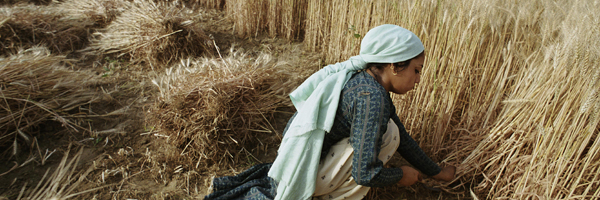Agriculture, gender and climate change
The agriculture sector is fundamental to the survival of people and communities, partly for the obvious reasons of food production and security. Beyond its tangible output, agriculture is a key economic activity, which in many contexts provides an income and is thus crucial for securing livelihoods. It is inextricably linked to the fulfillment of human rights, including the right to self-determination, food etc.
Agriculture is wholly dependent on climatic systems. Crops and livestock are highly sensitive to even minor climatic variation; developing countries – particularly those that depend on rain-fed agriculture – will feel the effects of climate change most strongly. These effects include changes in plant growth, spread of pests and diseases, increased exposure to heat stress, changes in rainfall patterns, greater leaching of nutrients from the soil during intense rains, greater erosion due to stronger winds and wildfires in drier regions.
In addition to being directly affected by a changing climate, agriculture and its related processes play a significant role in contributing to climate change. Most notably, the transition from traditional small-scale farming techniques to intensive large-scale systems has a number of implications. Land-use change, flooding areas for rice and sugarcane production, burning crop residue, raising ruminant animals and using nitrogen fertilizers, are examples of agricultural activities that release greenhouse gases into the atmosphere and also contribute to desertification and land degeneration.
Increasingly unsustainable methods of intensive agriculture, livestock farming and fishing are resulting in air pollution and food and water erosion, which are subsequently contributing to climate change and food security.
As a result, discussions surrounding agriculture have come to occupy a more central role within the UNFCCC negotiations.
Gender dimensions
The centrality of gender within these discussions is pertinent, given the important and varied roles of women in agriculture, their unequal access to productive resources, opportunities and produce, the breadth and depth of gendered agricultural knowledge and the overwhelming benefits of ensuring that the gender gap in this sector is closed.
The gendered division of labour within the agricultural sector is also highly relevant. More women work within the agricultural sector than men and women contribute significantly to smallholder subsistence agriculture, however, it is reported that this work is often informal "vulnerable" employment in the form of "contributing family workers". In this sense, women’s work is once again considered "unproductive" (in financial terms) and often brought in connection with reproduction.
Women in agriculture make up a larger proportion than men in many regions including Asia, Sub-Saharan Africa, the Middle East and North Africa. For example, estimates suggest that rural women produce up to 80% of the food in Africa. Male migration is one factor that can result in shifting production roles, as poverty, natural disasters, violent conflict and climate stresses often cause men to seek work in other areas leaving women solely responsible for agricultural labour.
In light of these significant contributions to food production, it is alarming that many women do not reap the benefits from this sector. According to the World Bank, women usually "operate smaller plots of land and farm less remunerative crops" and on average, women’s farms have lower yields. This is linked to their limited access to agricultural productive resources and opportunities like land, financial services, water, rural infrastructure, technology and labour.
Statutory and/or customary laws often restrict women's property and land rights and make it difficult for them to access credit and agricultural extension services, while also reducing their ability to make long-term investments in land rehabilitation and soil quality.
The so-called "green economy", which seeks market-based solutions to climate change, can also have negative impacts on women in agriculture. Land-grabbing has the greatest impact on those with insecure property rights (often women or indigenous peoples). Furthermore, it should be noted that the majority of land grabs are increasingly carried out for the production of bioenergy. Small-scale farms are often displaced and rural depopulation results in more limited access to schools and other family services.
Biofuels are also reported to lead to an increase in food prices, which can pose a particular challenge for women, who are conventionally responsible for feeding their families and widely regarded as key to food security in communities and households.
Gender dimensions are also important for agriculture in a broader sense. In industrialised countries, for example, many studies have found gendered differences in attitudes relating to agricultural production and products. These differences relate to views on food and health, ethical dimensions of food production and selection, nutritional attitudes and choices (such as eating less meat).
Response
The role of women in agriculture has received growing attention from key institutions and UN bodies in recent years.
With women contributing so significantly to the agricultural work force their knowledge is highly valuable, yet fair representation of this knowledge is not reflected in decision-making processes and institutions. Cultural and legal barriers need to be overcome so channels and methods of participation are present in women’s everyday lives (e.g. women's legalised land ownership, property rights and customs). The benefits of including women in decision-making processes and institutions is discussed in a book that grew out of the collaborative work done for FAO flagship report, The State of Food and Ag 2010-2011, Women in Agriculture. Closing the gender gap for development.
Women are important agents of climate change adaptation. Despite the challenges posed by increasing climate variability, recent evidence suggests that women who are already experiencing the effects of climate change related hazards are developing effective coping strategies. Women Feeding Cities is one such program where women are agents of climate change adaptation.
Given the key role played by women in agriculture, it is necessary that gender disaggregated data be made available for more countries and farming systems. This helps strengthen adaptation efforts by providing local climate information and enhancing meteorological and climatological knowledge.
Ongoing collaboration with rural women's networks is also crucial for the development of effective climate change policies and their implementation. These women provide important channels for sharing and disseminating information. Rural women should be included in developing information materials and dissemination strategies, reflecting a participatory approach to knowledge management. It is also important to build networks for grassroots women to promote equal land rights and support women’s groups who are working together to purchase land. As food and nutrition insecurity is a political and economic phenomenon fueled by inequitable global and national processes, responses must treat this issue as crucial matter of rights and social justice.

